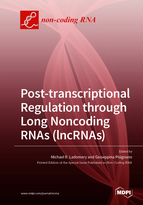Post-transcriptional Regulation through Long Non-coding RNAs (lncRNAs)
A special issue of Non-Coding RNA (ISSN 2311-553X).
Deadline for manuscript submissions: closed (31 December 2020) | Viewed by 61140
Special Issue Editors
Interests: RNA biology; RNA binding proteins; alternative splicing; splice factors; splice factor kinases; mRNA translation; microRNAs
Special Issues, Collections and Topics in MDPI journals
Special Issue Information
Dear Colleagues,
It is increasingly apparent that noncoding RNAs play a major role in gene regulation. In particular, it is now undisputed that microRNAs are involved in several key developmental and pathological processes. But it is also clear that other types of regulatory noncoding RNAs exist; in particular, long noncoding RNAs (lncRNAs). These lncRNAs exert their biological functions through a bewildering array of mechanisms, including a direct effect on epigenetic regulation through the modification of chromatin, as well as the direct modulation of protein activity and localization. However, it is also clear that lncRNAs work post-transcriptionally. They are involved in the regulation of expression and activity of other ncRNAs including microRNAs. They contribute to the regulation of alternative splicing, an increasingly key process in the regulation of gene expression. LncRNAs are also involved in the regulation of RNA editing, export, translation and stability. The focus of this Special Issue is on post-transcriptional regulation of gene expression by lncRNAs. A full understanding of lncRNA biology needs to include a better understanding of how they contribute to gene regulation post-transcriptionally in both normal development and disease.
Dr. Michael R. Ladomery
Guest Editor
Dr. Giuseppina Pisignano
Co-Guest Editor
Manuscript Submission Information
Manuscripts should be submitted online at www.mdpi.com by registering and logging in to this website. Once you are registered, click here to go to the submission form. Manuscripts can be submitted until the deadline. All submissions that pass pre-check are peer-reviewed. Accepted papers will be published continuously in the journal (as soon as accepted) and will be listed together on the special issue website. Research articles, review articles as well as short communications are invited. For planned papers, a title and short abstract (about 100 words) can be sent to the Editorial Office for announcement on this website.
Submitted manuscripts should not have been published previously, nor be under consideration for publication elsewhere (except conference proceedings papers). All manuscripts are thoroughly refereed through a single-blind peer-review process. A guide for authors and other relevant information for submission of manuscripts is available on the Instructions for Authors page. Non-Coding RNA is an international peer-reviewed open access semimonthly journal published by MDPI.
Please visit the Instructions for Authors page before submitting a manuscript. The Article Processing Charge (APC) for publication in this open access journal is 1800 CHF (Swiss Francs). Submitted papers should be well formatted and use good English. Authors may use MDPI's English editing service prior to publication or during author revisions.
Keywords
- RNA biology
- Long noncoding RNAs (lncRNAs)
- Short noncoding RNAs, microRNAs
- Post-transcriptional regulation
- Alternative splicing
- RNA editing, RNA export, mRNA translation and stability
- RNA binding proteins








